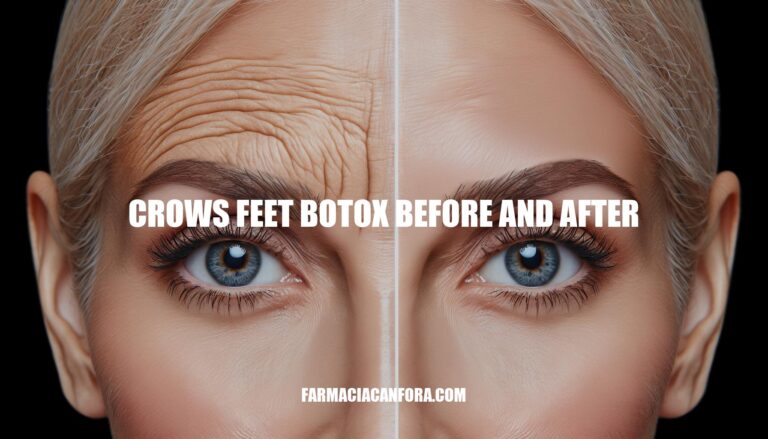Crow’s feet are the fine lines that appear at the outer corners of the eyes, often becoming more pronounced with age and frequent facial expressions like smiling or squinting. Many people seek Botox treatments to smooth these wrinkles, aiming for a more youthful and refreshed appearance. Botox works by temporarily relaxing the muscles around the eyes, reducing the visibility of crow’s feet and preventing them from deepening further.
What are Crow’s Feet?
Crow’s feet are fine lines and wrinkles that appear at the outer corners of the eyes. They are often referred to as “laugh lines” or “smile lines” because they become more prominent when you smile or laugh.
Causes of Crow’s Feet:
- Facial Movements: Repeated actions like squinting, laughing, and smiling cause creases in the skin.
- Aging: As we age, the skin loses collagen and elastin, making it less elastic and more prone to wrinkles.
- Environmental Factors: Exposure to UV rays, pollution, and smoking can accelerate the formation of crow’s feet.
- Skin Characteristics: The skin around the eyes is thinner and has fewer oil glands, making it more susceptible to dryness and wrinkles.
Understanding these causes is crucial before considering treatments like Botox. Knowing what contributes to crow’s feet helps in making informed decisions about prevention and treatment options.
How Botox Works for Crow’s Feet
Botox, derived from botulinum toxin type A, works by blocking nerve signals to the muscles around the eyes, specifically the orbicularis oculi muscle. This muscle is responsible for the contractions that cause crow’s feet. By relaxing these muscles, Botox prevents the skin from folding and forming wrinkles when you smile or squint.
Here’s a visual representation of the effectiveness of Botox for crow’s feet:
Before and After Botox for Crow’s Feet:
As you can see, the lines around the eyes are significantly reduced, giving a smoother and more youthful appearance. The results typically last for about three to four months.
Before Treatment: What to Expect
Pre-Treatment Process for Botox
-
Consultation:
- Assessment: A qualified professional evaluates your facial muscles and discusses your aesthetic goals.
- Medical History: Disclose any medications or supplements you’re taking to avoid complications.
-
Preparations:
- Avoid Certain Medications: Stop taking anti-inflammatory drugs like aspirin and ibuprofen at least a week before the appointment to reduce bruising.
- No Alcohol or Smoking: Refrain from alcohol and smoking for at least 24 hours before treatment.
- Clean Skin: Ensure your face is clean and free of makeup on the day of the procedure.
Crow’s Feet Botox Before and After
- Before: Visible fine lines radiating from the corners of the eyes, often deepening with facial expressions.
- After: Smoother skin around the eyes with reduced visibility of crow’s feet, typically noticeable within 7-14 days post-treatment.
After Treatment: Results and Care
Post-Treatment Phase for Crow’s Feet Botox:
Immediate Effects:
- Bruising and Swelling: Common around the injection site, especially in the laugh line area.
- Redness and Soreness: Minor and temporary.
- Headaches: Some people might experience mild headaches.
Aftercare:
- Avoid Manipulating the Area: Don’t rub or massage the treated area.
- Stay Upright: Avoid lying down for 3-4 hours post-treatment.
- Limit Strenuous Activities: Refrain from heavy exercise for at least 6 hours.
- Cool Compress: Use an ice pack to reduce swelling, but only for short periods.
Crow’s Feet Botox Before and After Results:
- Before: Visible fine lines fanning out from the corners of the eyes.
- After: Noticeable reduction in the visibility of crow’s feet, resulting in a smoother and more youthful appearance. Results typically start to appear within a few days and can last for 3-4 months.
Real-Life Examples
Here are some examples of real patients who have undergone Botox treatments for crow’s feet, showcasing the transformation and benefits:
- SDBotox: Before and after images from an SDBotox client who received Botox for crow’s feet. The visual results speak for themselves.
- Botox Cosmetic: Photos and videos taken at full smile before, 7 days after, and 30 days after treatment with BOTOX® Cosmetic.
- Blue Water Spa: Real patient results of crow’s feet Botox before and after photo gallery in Raleigh Durham.
- The Wright Center for Women: Real patients who have had Botox injections, showing dramatic transformations.
These examples illustrate the potential of Botox in enhancing your appearance within a short period.
Crow’s Feet: Causes, Treatment Options, and Aftercare
Crow’s feet are fine lines that appear at the outer corners of the eyes, often becoming more pronounced with age and frequent facial expressions. Botox treatments can smooth these wrinkles by temporarily relaxing the muscles around the eyes, reducing their visibility and preventing them from deepening further.
The causes of crow’s feet include facial movements, aging, environmental factors, and skin characteristics. Understanding these causes is crucial before considering treatments like Botox.
How Botox Works for Crow’s Feet
Botox works by blocking nerve signals to the muscles around the eyes, specifically the orbicularis oculi muscle, which is responsible for the contractions that cause crow’s feet. The results of Botox for crow’s feet are typically noticeable within 7-14 days post-treatment and can last for 3-4 months.
Preparation and Aftercare for Botox Treatment
Before undergoing Botox treatment, it’s essential to consult a qualified professional, disclose any medications or supplements you’re taking, and avoid certain medications, alcohol, and smoking. After the treatment, it’s crucial to follow proper aftercare instructions, including:
- Avoiding manipulating the treated area
- Staying upright
- Limited strenuous activities
- Using a cool compress to reduce swelling
Benefits of Botox for Crow’s Feet
The benefits of Botox for crow’s feet include:
- A smoother and more youthful appearance
- Reduced visibility of fine lines
- A noticeable transformation within a short period


